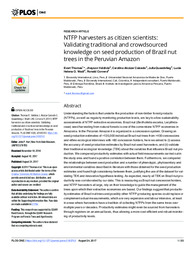NTFP harvesters as citizen scientists: Validating traditional and crowdsourced knowledge on seed production of Brazil nut trees in the Peruvian Amazon.
NTFP harvesters as citizen scientists: Validating traditional and crowdsourced knowledge on seed production of Brazil nut trees in the Peruvian Amazon.
Author(s): THOMAS, E.; VALDIVIA, J.; CAICEDO, C. A.; QUAEDVLIEG, J.; WADT, L. H. de O.; CORVERA, R.
Summary: Understanding the factors that underlie the production of non-timber forest products (NTFPs), as well as regularly monitoring production levels, are key to allow sustainability assessments of NTFP extractive economies. Brazil nut (Bertholletia excelsa, Lecythidaceae) seed harvesting from natural forests is one of the cornerstone NTFP economies in Amazonia. In the Peruvian Amazon it is organized in a concession system. Drawing on seed production estimates of >135,000 individual Brazil nut trees from >400 concessions and ethno-ecological interviews with >80 concession holders, here we aimed to (i) assess the accuracy of seed production estimates by Brazil nut seed harvesters, and (ii) validate their traditional ecological knowledge (TEK) about the variables that influence Brazil nut production. We compared productivity estimates with actual field measurements carried out in the study area and found a positive correlation between them. Furthermore, we compared the relationships between seed production and a number of phenotypic, phytosanitary and environmental variables described in literature with those obtained for the seed production estimates and found high consistency between them, justifying the use of the dataset for validating TEK and innovative hypothesis testing. As expected, nearly all TEK on Brazil nut productivity was corroborated by our data. This is reassuring as Brazil nut concession holders, and NTFP harvesters at large, rely on their knowledge to guide the management of the trees upon which their extractive economies are based. Our findings suggest that productivity estimates of Brazil nut trees and possibly other NTFP-producing species could replace or complement actual measurements, which are very expensive and labour intensive, at least in areas where harvesters have a tradition of collecting NTFPs from the same trees over multiple years or decades. Productivity estimates might even be sourced from harvesters through registers on an annual basis, thus allowing a more cost-efficient and robust monitoring of productivity levels.
Publication year: 2017
Types of publication: Journal article
Unit: Embrapa Rondônia
Observation
Some of Embrapa's publications are published as ePub files. To read them, use or download one of the following free software options to your computer or mobile device. Android: Google Play Books; IOS: iBooks; Windows and Linux: Calibre.
Access other publications
Access the Agricultural Research Database (BDPA) to consult Embrapa's full library collection and records.
Visit Embrapa Bookstore to purchase books and other publications sold by Embrapa.

